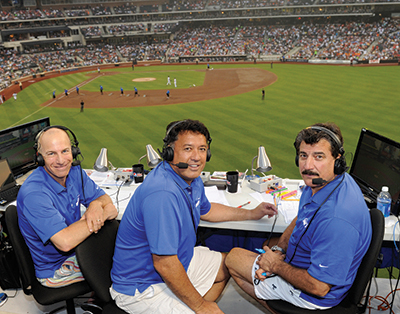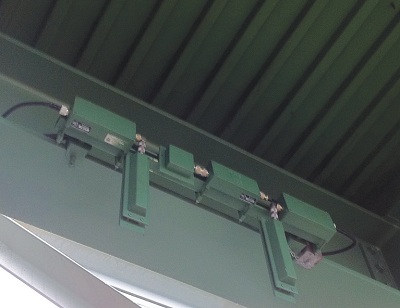Sports Nets Tweak MLB Coverage

This season, SNY, the New York Mets regional sports network, will expand their pregame coverage and increase their use of RF and robotic cameras.
BALTIMORE—Look for a greater emphasis on increasingly economical point-of-view cameras, with a more diverse body of work from the roving cameraman’s handheld, from inside the ballpark and possibly beyond. And do it via multiple screens and social media.
That’s what’s on tap for the 2013 Major League Baseball season from regional sports networks as they address an audience that’s always hungry for an enhanced viewing experience, whether the source is 96 inches wide or fits in the palm of one’s hand.
ROUNDING FIRST
At Coors Field in Denver, home of the Colorado Rockies, the addition of the new Coors Clubhouse behind home plate meant moving the backstop about six feet forward, shortening the park’s dimensions. “That will affect the broadcast,” said Ken Miller, executive producer for the Rockies’ carrier, Root Sports Rocky Mountain.
That meant refibering the cable for the position cameras,” he said, which now include two Fletcher robotic cameras at the backstop: one facing the field, the other directed toward the leftfield line.
“They can only be 10 feet [as opposed to 15] up now, which enhances the angle,” he added. “Shooting from that height has proven effective elsewhere, as the lower angle gives a better shot of the pitcher/batter from behind the catcher.”
Root is also adding POV GoPro cameras by the water structure in centerfield. “We originally shot from both bullpens, then added high home, with centerfield and the fountains new this year,” he said, noting that Root may also mount a camera on a catcher’s mask, as was done in the bullpens last year; and is also upgrading its high-speed cameras to the lighter, higher resolution SupreMoPhantom v642.
The professional video industry's #1 source for news, trends and product and tech information. Sign up below.
The Rockies, Miller said, are among the few teams to employ a full-time RF roving camera, a Panasonic P2. “That gives us some unusual angles, from the stands and elsewhere; and this year, we’re shooting outside the park at 20th and Blake” in the city’s happening LoDo area. “That means more fan interaction and fun outside.”
HEADING TO SECOND
New England Sports Network, the TV home of the Boston Red Sox, will also take a new approach with RF cameras at Fenway Park this season. In the “Green Monster” seats atop the park’s famed 37- foot high left-field wall and throughout the ballpark, NESN will employ a JVC GYHD250 RF camera with a Fujinon 13x3.5 wide zoom lens.

NESN has installed a JVC GY-HD250 RF camera with a Fujinon 13x3.5 wide zoom lens to serve as a POV camera atop Fenway Park’s infamous “Green Monster.” “It’s a very small HD camera that allows us to walk around in the close confines of Fenway,” said Mike Narracci, senior coordinating director for NESN, of the anything-but-symmetrical ballpark.
Naracci noted that the sportsnet will also experiment using the RF camera when roving outside of Fenway during the pregame show on adjacent Yawkey Way, as the crew analyzes optimum antenna placement.
Also new from NESN is a 16:9 (or letterbox) presentation for SD viewers, which will allow the sportsnet to take advantage of the full HD aspect ratio; and the use of Phizzle’s social media Chyron interface to intensify the engagement of the fans on pre- and post-games shows.
SNY and the New York Mets will also be broadening broadcast horizons by featuring a new expanded pregame show that will kick off the 2013 season at Citi Field, outside of the Jackie Robinson Rotunda.
Comprehensive coverage will increase from 30 to 60 minutes, said Curt Gowdy, Jr., SNY’s senior vice president of production and executive producer, with the first half-hour called “Mets First Pitch,” followed by “Pepsi Max Mets Pre-Game Live.”
During the 2013 campaign, SNY will also be more aggressive in utilizing an RF handheld and the DirecTV blimp during select series; and will utilize one of its four Sony HDC series robotic cameras behind low-home in a specially-encased protective camera box, which is new to the broadcast.
He added that SNY is also beefing up its social media presence with live online chats in-game, the use of “Tout,” an online microblogging service that enables users to send and view 15-second videos, as well as engage fans with pre- and in-game phone calls—on a seven-second delay, of course.
PLAT AT THIRD
At AT&T Park in San Francisco, Comcast SportsNet Bay Area is also tweaking its use of POV cameras to broadcast the World Series Champion Giants. According to David Koppett, senior executive producer of live events, the sportsnet is expanding its use of the cameras “now that the technology has improved and the price has dropped.”
What else is relatively new is that the Bradley Engineering Cam-Ball 2 (or “cue ball”); it was used occasionally in the booth last year, but it’s going full-time in 2013. “That will allow us to reposition one of the two Fletcher robotics cameras that are mounted on the screen for a shot up the right-field line,” Koppett said.
As for the POV cameras, CSN will add three GoPros that will be mounted at various locations in AT&T. “We haven’t put one on the giant Coke bottle (behind the leftfield bleachers) yet, but who knows; last year we tried it in high centerfield, with a fish eye lens, for a scenic,” he said. “It was beautiful.”
STEALING HOME
Yet another team investing in POV technology is Fox Sports North, which broadcasts Minnesota Twins games. “We’ve been using the GoPro HERO3 cameras in front of the booth and elsewhere, which is standard,” said Matt Gangl, senior director for the sportsnet, “but last year, we started moving them around Target Field.
“The POV cams cost up to $300 and the ROI is good,” said Gangl, noting that his broadcast team may try some new locations this year—including in the bases or in the bat rack, both during batting practice. “I’d like to try to mount one on a batting helmet or maybe even [inside] the end of a bat,” he said, noting that the cameras can even be used to shoot stills in certain circumstances, then used to create time-lapse galleries.
But the biggest news in the Twin Cities is the addition of the new HD studio that includes three Ikegami EC77 cameras, including a Jimmy Jib, and a GVG Kayenne switcher. It’s just two blocks from Target Field and is accessible via indoor skywalk, which is greatly appreciated given Minnesota’s pronounced seasonal climate.
“We had been using a 16:9 SD studio,” said Gangl, who mentioned that with the new studio comes a new platform area in rightfield, which will include a secondary set for (you guessed it) social media.
“That way, we can take advantage of the second screen that most people are using for opinion polls, fan reaction, etc.,” said Gangl, adding, “Anyway to get a unique perspective for a fan has to be beneficial.”
Mark R. Smith has covered the media industry for a variety of industry publications, with his articles for TV Technology often focusing on sports. He’s written numerous stories about all of the major U.S. sports leagues.
Based in the Baltimore-Washington area, the byline of Smith, who has also served as the long-time editor-in-chief for The Business Monthly, Columbia, Md., initially appeared in TV Technology and in another Futurenet publication, Mix, in the late ’90s. His work has also appeared in numerous other publications.

